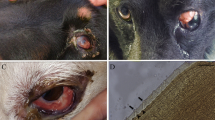Summary
A nematode worm 8.3 mm long removed from the anterior chamber of an Australian patient's eye was identified as a femaleDirofilaria immitis. A review of another worm previously removed from the eye of another patient showed that this was also a femaleD. immitis. Both worms were subnormal in size; this is believed to be due to their development in an unnatural host. These eye infections probably result from the normal migrations of the developing worms in the subcutaneous tissues which occur prior to their entry into the venous circulation, but the exact route of entry into the eye cannot be suggested.
Zusammenfassung
Ein aus der vorderen Augenkammer eines australischen Patienten entfernter Fadenwurm von 8,3 mm Länge wurde als weiblicheDirofilaria immitis identifiziert. Die Überprüfung eines zuvor aus dem Auge eines anderen Patienten entfernten Wurmes ergab, daß es sich ebenfalls um eine weiblicheD. immitis handelte. Beide Würmer hatten subnormale Größe und es wurde angenommen, daß dies auf ihrer Entwicklung in einem naturfremden Wirt beruhte. Diese Augeninfektionen sind vermutlich die Folge der normalen Wanderungen der sich entwickelnden Würmer in den Unterhautgeweben, die vor ihrem Eintritt in das venöse Blut stattfinden, doch kann keine Erklärung hinsichtlich des eigentlichen Eintrittsweges in das Auge gegeben werden.
Similar content being viewed by others
Literature
Brine, J. A. S., Finlay-Jones, L. R., Charters, A. D. Pulmonary dirofilariasis-A case in Western Australia. Med. J. Aust. 2 (1971) 1238–1241.
Moorhouse, D. E., Abrahams, E. W., Stephens, B. J. Human pulmonary dirofilariasis in Queensland. Med. J. Aust. 2 (1971) 1230–1233.
Moorhouse, D. E., Abrahams, E. W., Stephens, B. J. Human pulmonary dirofilariasis associated with pleural effusion. Med. J. Aust. 2 (1976) 902–903.
Faust, E. C., Russell, P. F., Jung, R. C. Craig and Faust's clinical parasitology, pp. 392–393. Lea and Febiger, Philadelphia 1970.
Lavers, D. W., Spratt, D. M., Thomas, C. Dirofilaria immitis from the eye of a dog. Aust. Vet. J. 45 (1969) 284–286.
Spratt, D. M., Mallett, G., Derrington, P. C., Thomas, C. MaleDirofilaria immitis from the eye of a dog. Aust. Vet. J. 47 (1971) 124.
Orihel, T. C. Morphology of the larval stages ofDirofilaria immitis in the dog. J. Parasitol. 47 (1961) 251–262.
Anderson, R. C. Description and relationship ofDirofilaria ursi Yamaguti, 1941, and a review of the genusDirofilaria Railliet and Henry, 1911. Trans. R. Can. Inst. 29 (1952) 35–64.
Kerkenezov, N. Intra-ocular filariasis in Australia. Br. J. Opthalmol. 46 (1962) 607–615.
Kume, D., Itagaki, S. On the life-cycle ofDirofilaria immitis in the dog as the final host. Br. Vet. J. 111 (1955) 16–24.
Author information
Authors and Affiliations
Rights and permissions
About this article
Cite this article
Moorhouse, D.E. Dirofilaria immitis: A cause of human intra-ocular infection. Infection 6, 192–193 (1978). https://doi.org/10.1007/BF01641909
Received:
Issue Date:
DOI: https://doi.org/10.1007/BF01641909




